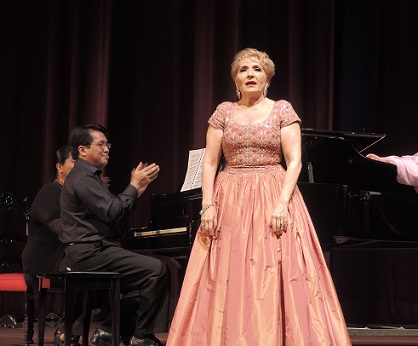By JOSEPH CORTES
Photos by KIKO CABUENA and ANNA LEAH SARABIA

Experienced concertgoers have observed that the acoustics of Meralco Theater is not favorable for concerts of classical music.
It has something to do with the way the theater was designed. Rather than the box-shape you would find in most theaters, such as the old PhilamLife Theater and the Main Theater of the Cultural Center of the Philippines, it is a rectangle; sound waves have a hard time traveling to listeners seated at the back, or the upper section of the theater, from the stage, because they would need to cover the breadth of the theater first, before traveling its length.
In a pop concert where everything is played with amplification, this would not present a problem. But not so with classical music concerts, particularly those devoted to the human voice.
World-renowned soprano Nelly Miricioiu must have recognized this fact during rehearsals at the hall, because even before she sang one note during her recital last March 6, she graciously asked all those seated at the back of the theater to come forward and occupy the seats nearer the stage.
“We are performing without amplification,” she declared, and apologized to the audience for the inconvenience of having them stand up from their seats and move forward.
Miricioiu’s decision to ask everyone to occupy the seats at the front of the house was a stroke of genius. Doing so, she was able to offer Manila’s opera-loving crowd a chance to marvel at her vocal prowess. She was able to conserve her voice during the first half, unleashing its full power by the second half of the recital, which was devoted to opera arias by Giuseppe Verdi, Gioachino Rossini and Vincenzo Bellini.

The first half of the program featured art songs by Ottorino Respighi, Ernest Chausson, Frederic Chopin/Pauline Viardot and Tiberiu Brediceanu. For this part of the concert, the more intimate setting the soprano devised allowed her to make full expressive use of her voice. Indeed, Miricioiu is known not just for her powerful singing, but also for her expressive capacities.
Italian art songs require a different vocal placement than French art songs, which is a result of the language being sung. In just a matter of seconds, you hear how the soprano is able to transform her instrument from the more robust sound in the Respighi to the more nasal sound of the French songs. Likewise, she could sing quietly when needed and still remain audible to the audience.
But it was not just her ability to control the sound of her voice that invited attention, but her characterization, too. She could will her voice to sound like a young girl’s, excited to be at a ball (“La Danse” by Chopin-Viardot), or deep and mournful as she sang of the passage of time (“Le Temps de Lilas” by Chausson).
In singing folks songs from her native Romania, she asked the audience to “listen with your hearts/” Although there is a screen to the side of the stage that offered surtitles of all songs sang that night, the soprano explained that Romanian songs are very much like Filipino songs: they are songs of deep emotion and express the feelings of the people.
The folk songs were lively and engaging, particularly the final one, where a shepherd girl flirts with a young man, telling him she loved him the way she loved her country’s wide-open fields.
The reason as to why she compared Romanian folk songs to Filipino songs was based apparently on her familiarity with a couple of Filipino art songs. Also on the program that evening were Nicanor Abelardo’s “Mutya ng Pasig,” Manuel Velez’s “Sa Kabukiran,” and “Ay! Kalisud,” which she sang as one of her encores.

It must be said that hearing Filipino songs sung by foreigners greatly expands our appreciation of these songs. In Miricioiu’s hands, “Mutya ng Pasig” sounded freshly spun, very much the art song that it is. On the other hand, she displayed vibrant bel canto singing in “Sa Kabukiran,” relishing the virtuoso display of trills that is the highlight of the song.
Of course, the soprano made light of how some dismiss bel canto singing as “easy.”
“I suggest they give it a try,” she expressed in jest after tossing of the brilliant runs in Rossini’s “Bel raggio lusinghier” from Semiramide with such aplomb. It was a ravishing performance that Manila rarely hears in concerts, so much that it literally brought the house down.
The mad scene from Bellini’s Il Pirata (“Col sorriso d’innocenza… Oh, sole! ti vela”) that followed was just as brilliant with its moments of vivid drama, followed by an equally magnificent cabaletta in the second half of the scene.
On the other hand, the arias from Verdi’s Aroldo and Simon Boccanegra were both dramatic showpieces. In fact, the role of Mina in Aroldo is a recent addition to Miricioiu’s repertoire.
In the Act 2 scena (“Oh Cielo, dove son’io?… Ah, del sen si quella tomba), she showed her mastery of the role in way she handled the inner turmoil of the character as she confesses her misdeed and asks help from her dead mother for heaven’s intercession.
It’s a pity, though, that Miricioiu’s recital was only accompanied by the piano. The opera arias required orchestral accompaniment to provide her performance with the full dramatic impact. However, pianist Najib Ismail was a worthy partner for the soprano’s return to the country after an absence of more than 30 years. From the selection of songs to the selection of arias, he provided the canvas on which the soprano’s mesmerizing colorful singing was painted.
Brava, Nelly!



